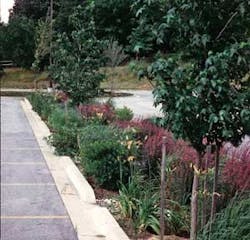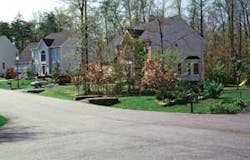Low Impact Development approach slows down drainage, reduces pollution
Hydrology matching, an innovative approach to managing stormwater runoff, reduces downstream flooding and removes pollutants from runoff.
In the 1990s, US federal mandates pushed large communities to begin implementing programs to reduce pollutants in stormwater runoff. Now, smaller communities are putting their own programs into action. Many communities believed that end-of-pipe treatment systems, such as stormwater detention facilities designed to capture and retain runoff, made the most sense to reduce pollutants.
Increased pollutant loading, however, is not the only impact of land development. New parking lots and buildings contribute to the loss of natural rainwater percolation into soils and evapotranspiration into the atmosphere. When concrete or asphalt are added to the landscape, or when heavy equipment compacts the natural soil structure, rainwater is less likely to be absorbed and more likely to become runoff traveling to receiving waters via compacted soils and slick new streets and parking lots. This action not only delivers a new pollutant stream to local rivers and lakes, it changes the flow in those water bodies and contributes to erosion.
With today’s accelerating pace of land development, some communities are starting to realize that end-of-pipe approaches may not adequately address downstream impacts from the quantity and quality of urban runoff. Engineers, planners and biologists are realizing that the receiving streams and rivers can be preserved if residential and commercial communities can be built to allow stormwater to drain from the land in the way it did before the development. Rather than develop land using traditional curb-and-gutter streets, large areas of impervious paving and a “drain it quickly” philosophy, some development projects are, instead, seeking to slow the water down. This approach is known as hydrology matching.
Hydrology refers to the duration, frequency, and magnitude of the stormwater runoff draining from a site after a specific rain event. Hydrology matching seeks to match the post-development runoff pattern with the pre-development runoff pattern. This means that the development is essentially invisible-rivers and streams act as they did before the development was completed. Engineers and planners have seen that hydrology matching not only helps with reducing downstream flooding and erosion, it can also help to remove pollutants from runoff.
A technique pioneered in the US state of Maryland for applying hydrology matching to new development is called Low Impact Development (LID). The goal of LID is to create a hydrologically-functional lot. Several techniques are combined-resource conservation, intelligent site design and pollution prevention measures-to control runoff discharge, frequency and water quality well before the runoff reaches receiving waters. The solutions are very different from traditional development approaches and require more up-front analysis to apply. However, a side effect of LID’s emphasis on adding hydrologically functional plantings and gardens is often a more aesthetically pleasing development.
For example, a parking lot once paved from end to end, surrounded by a curb, and draining to a series of pipe inlets can, instead, drain to several planting areas designed to absorb and infiltrate rainwater. For residential developments incorporating LID, homes may incorporate rain barrels to retain runoff from rain gutters; streets incorporate rain swales to filter and slow runoff. The layout and grading differs from traditional designs, in which the street is often at the low point to convey stormwater flow towards hard-piped drainage. Frequently in an LID project the street is placed on a ridge line so rainwater can flow towards lawns and remaining runoff can reach a riparian corridor where a property’s back fence would typically be located. This allows all runoff to be filtered through vegetation and provides more opportunity for infiltration.
LID cannot always be applied. Communities with impervious soil types, flat topography or heavy rainfall may have to rely more on detention features for stormwater management. Communities that can entertain the possibility of using LID may, however, see some advantages. For example, detention ponds used in traditional stormwater management require regular inspection and maintenance tasks that are usually borne by a municipality. The upkeep of LID features can be shared among business and residential landowners following an education program to emphasize the role their rain gardens play in the environment and as part of the community’s drainage infrastructure.
The application of end-of-pipe solutions used in the 1990s is well understood by land development engineers. In many regions, the review and permit process for new developments presumes its implementation. End-of-pipe solutions may fit with current land development practices, but they may not be the best way to manage stormwater runoff from development. Communities should ask themselves, “What do we want our stormwater infrastructure and receiving waters to look like 10 years from now?” The answer may not always lead planners to rely on traditional end-of-pipe technologies when considering the impact to downstream waters.
Author’s note
Michael F. Bloom, PE, CFM, DEE, CPSWQ is a project manager for consulting firm PBS&J’s Water Quality Management Practice. For more information, contact him by email at: [email protected] or visit the website: www.pbsj.com.


